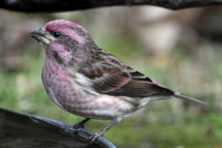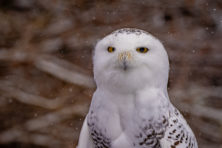Door to Nature: Resident Finches of Door County
- Share
- Tweet
- Pin
- Share

True finches are in the Fringillidae (frin-JIL-eh-dee) family. There are a half dozen species that are native mainly to the western parts of the United States, but a few occasionally show up in Wisconsin during migration seasons.
Three species are most common in our area: the purple finch, house finch and American goldfinch. This winter, many goldfinches visited my feeders, sometimes 20-30 at a time. Other days, they were absent.
Some people who feed birds may not recognize the goldfinch during the winter because its plumage is quite drab, with light brown to pale yellow feathers. But as April begins, the males develop a brilliant yellow body color and black crown feathers.
A favorite winter food for goldfinches is the seeds of paper birches. We have found seed debris on the snow below birch trees, indicating visits from these traveling flocks. When they arrive in the yard, they come in all at once, and then, when frightened, they are gone in an instant.
We used to feed them Niger thistle seeds in small, hanging mesh bags, but the seeds can become dried to the point where finches do not eat them. Some people have purchased thistle seeds, and no birds will eat them, so I have not been using those in my feeders.
Thistles are very important in the life of American goldfinches. They nest quite late in the season because thistle down – the long, fine hairs that the plant produces as it goes to seed – are used in the nest. Some thistle species are native, but some are noxious weeds that need to be controlled.
Goldfinches nest in woodland edges along weedy or cultivated fields, as well as in suburbs. Females prefer to place the nest in the fork of a branch in deciduous trees anywhere from 1 to 30 feet above the ground. The nest is lined with fine plant fibers and can sometimes be so tightly woven that it may hold rainwater. Brown-headed cowbirds prey upon them easily.
These five-inch goldfinches are found coast to coast in the United States from southern Canada to the near south. They may join flocks of pine siskins and common redpolls during the winter because these birds all eat weed seeds during the “off-season.”
Purple finches are also native, and many migrate south during the winter, mainly in the eastern part of the country. They nest all across Canada, but only in the eastern part of the northern U.S. They are replaced by the Cassin’s finch in the mountains of the western United States.
The purple finch nests mainly in conifer trees in open conifer or mixed woodlands. These six-inch beautiful singers do visit feeders and bird baths. I remember a comment made by the grandmother of my late husband, Roy, when she saw a male purple finch in their backyard bird bath. She watched it splash around and said, “It looks like he was dipped in raspberry juice!” Their color is rosier than that of the similar house finch.
Last winter I saw a lot of purple finches in the yard and at the feeders. This year, almost none. Their winter migrations can vary greatly from year to year.
It was 1986 when we saw the first house finches in Door County. This is a species native to the far west. Apparently, some had been captured and were being sold in pet shops in the east. When the federal wildlife authorities learned of this, many pet-shop owners just released these captive birds into the wild. That was back in about 1940.
A small number of them began nesting here, but their numbers are not very high. We felt that the few that were seen here 30 years ago may just be heading back to their native homeland. Roy called them “Hollywood finches” and said they were going back to their home state.
A male house finch has more brown feathers – is generally red with less of a purple tinge – than a male purple finch, which is closer to a magenta color.
Females can be told apart by their cheek feathers: A purple finch has a brown cheek patch with a white, slightly curved horizontal line above that. A female house finch’s cheek is more evenly brown.
All finches will be singing as the breeding season nears. The goldfinch sings, but it waits until late summer before nesting. Enjoy the marvelous colors and songs of our breeding birds.



